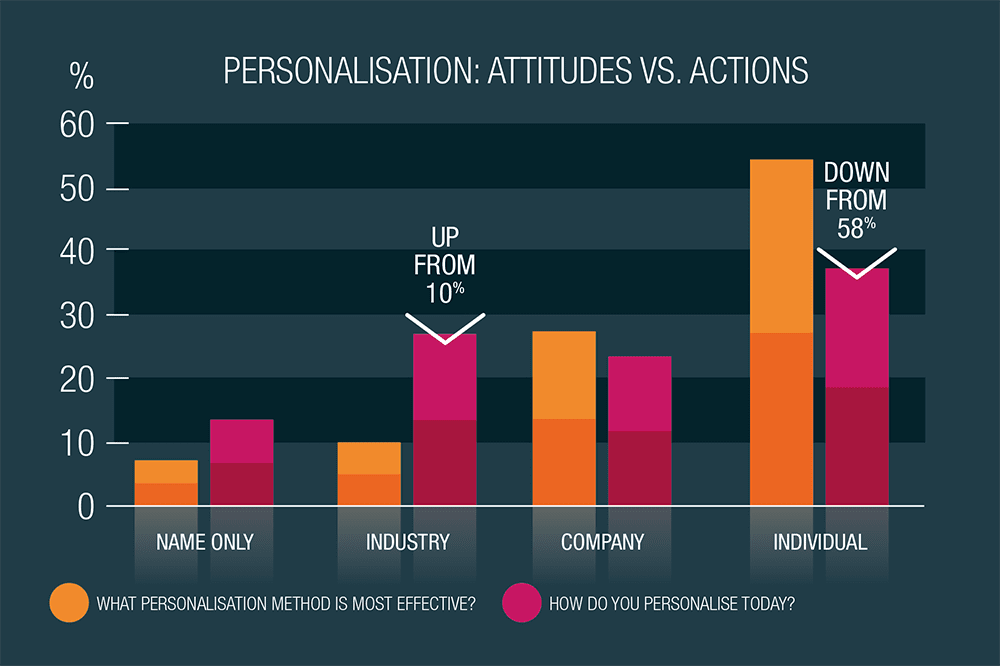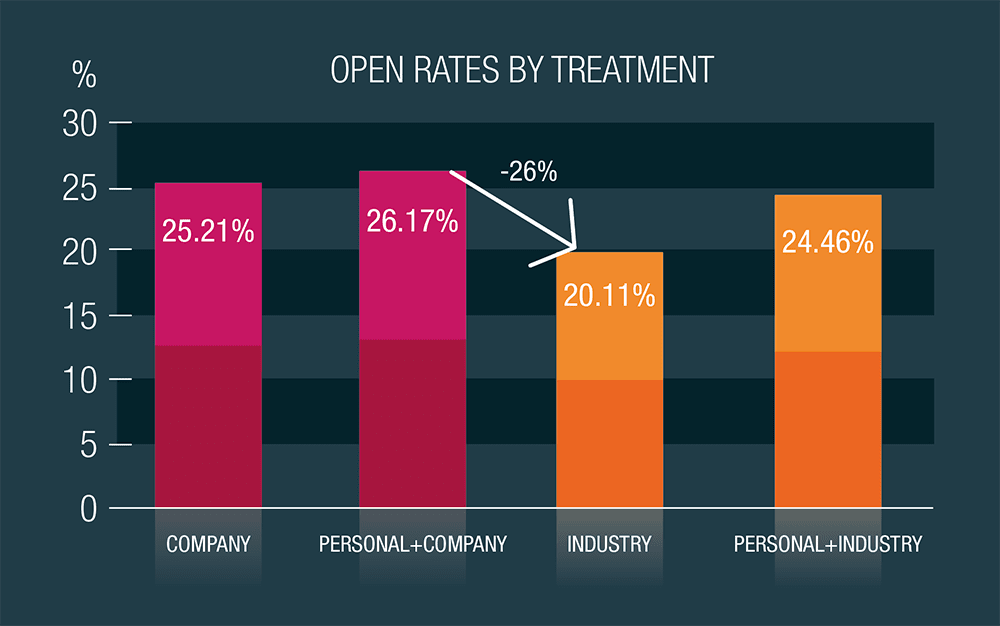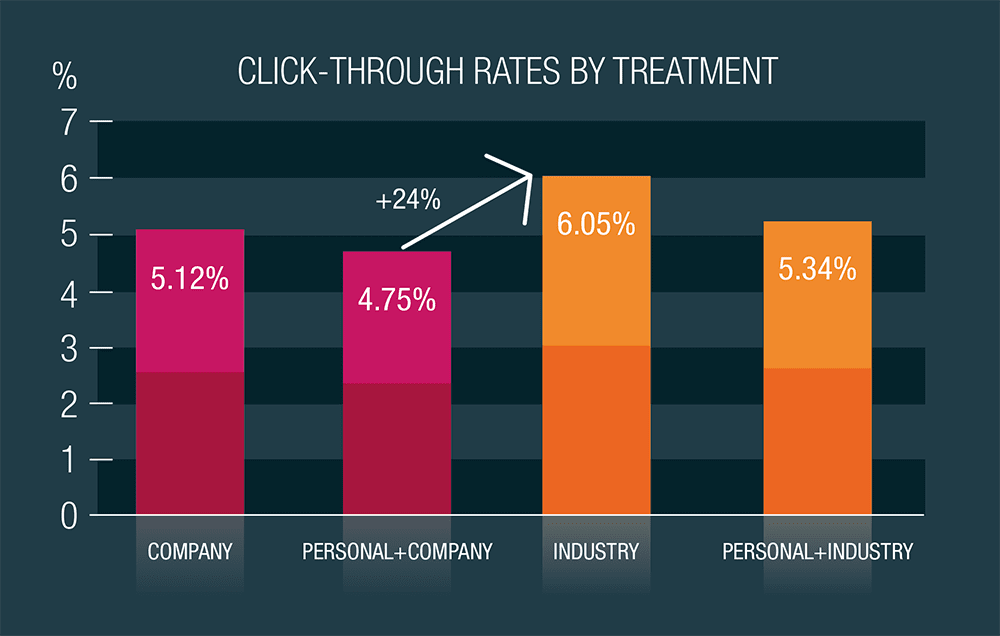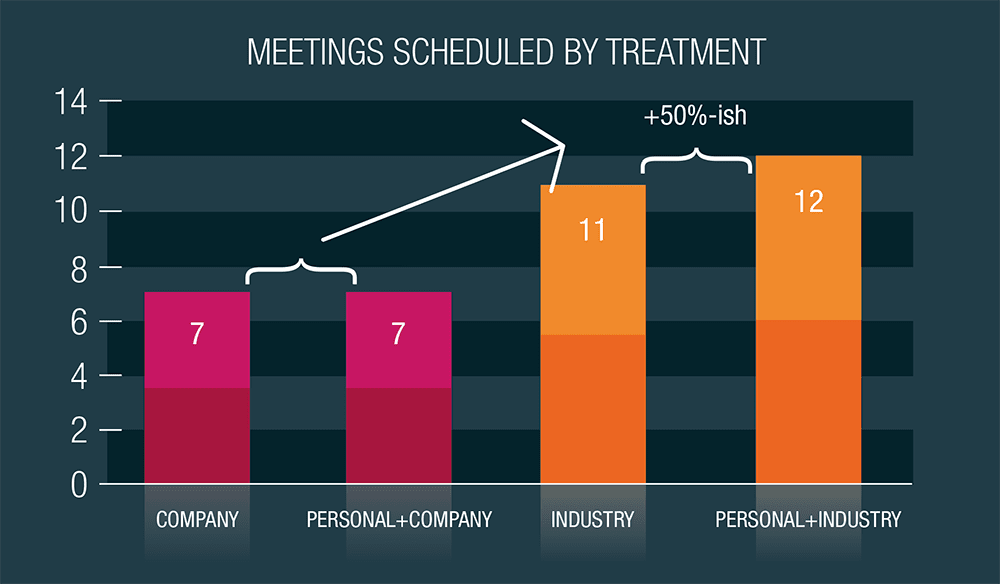Putting personalization to the (field) test
26th June 2019 | Tim Riesterer

Here we set out to discover what sort of communications personalization actually does drive action.
One of the most-quoted lines in movie history comes from the classic film The Godfather. After Michael, the emerging leader of the Corleone crime family, lays out a ruthless plan for revenge against his enemies, he punctuates his strategy with the memorable line: “It’s not personal. It’s strictly business.”
If only real life were that straightforward.
In B2B sales and marketing, personal is business. Big business. As more organizations rush headlong into account-based approaches, sellers are expected to amass an encyclopedic understanding of their targets – everything from earnings data to competitive intelligence to where the CEO went to grammar school. Meanwhile, the B2C experience has only heightened the expectation that you’ll be able to transform all that data into crisp, tailored communications that have been personalized down to the last period.
But is all this personalization truly necessary? And, more importantly, is it working?
The goal of every personalization strategy is to win more business. So, while it’s important to ensure your communications are relevant and engaging, the final measure of success is whether or not they snag new buyers. All that account research comes at a cost. It costs you time. It costs you resources.
It costs you dollars. And if your efforts fall flat, your time, resources, and dollars trickle right down the drain.
The question, then, is: what sort of personalization does drive action? What’s the best approach for developing and targeting those meaningful communications to generate tangible results? That’s what we set out to discover in our latest study. And this time, we raised the stakes. Instead of a rigorously constructed B2B simulation, we conducted a live field test using prospects and messages a little closer to home: our own.
Why put all the extra effort in to personalize to such a degree if you’re not seeing a meaningful uptick in meeting outcomes?
Diminishing returns of personalization
The Law of Diminishing Returns, broadly stated, refers to the point where a gain becomes less than the amount of money or energy invested to achieve that gain. Put into a marketing context, that means the response rates for an email campaign – whether measured as open rates, click-throughs, or meetings scheduled – should justify or, best case, outweigh the effort expended.
There are four ways companies personalize campaigns today, ranked here by the degree of effort required, from most to least:
- By individual: Trying to establish a personal connection using specific information about the prospect, such as prior positions, contacts in common, or shared interests.
- By company: Referencing news items, earnings reports, or other material to demonstrate your familiarity with that organization.
- By industry: Offering an observation or relevant insight about a trend or issue in the target’s industry.
- By name: Inserting the prospect’s name in the subject line, greeting, and/or opening paragraph.
Our first step was to survey more than 300 companies to understand which of the above methods they use today, as well as their confidence level in their chosen method. The goal was to expose any tension that existed between their declared preference (what they believed was the best approach to personalization) and their revealed preference (what they actually do).

Figure 1: Tension in personalization aspirations versus activity.
The results did uncover some tension (Figure 1). While the majority believe the more personalization the better, their actual efforts are, in their eyes, falling short: 58 percent believe the highest-effort personalization method – laboriously researching an individual and referencing personal details in the outreach – is the most effective approach; yet only 39 percent are achieving this degree of detailed personalization.
Similarly, while 28 percent believe personalizing by company is the most effective approach, only 22 percent are actually doing it. Meanwhile, industry-specific personalization fared only slightly better than the lowest-effort, name-only approach in terms of perceived effectiveness (10 percent and 8 percent, respectively), but came in second to the highest-effort individual approach in terms of actual practice (27 percent and 39 percent, respectively).
So, what can we glean from these results? It appears that companies believe that a highly targeted, highly individualized approach is the best form of personalization – but, while they make a valiant effort to follow this philosophy, many end up having to settle for the industry-specific approach that they view as less effective.
This means there are a lot of sellers out there expending a lot of time and effort on personalization and likely beating themselves up for not doing more. But should they be?
Field trial
For the field trial, we targeted 7,0001 names in a prospect database that met the following conditions:
- Each was an ice-cold prospect; that is, an individual who had had no prior interaction with the company.
- Each fitted the ideal client profile in terms of vertical market, company size, and title.
Next, we constructed a set of emails that contained identical solution offers and calls to action, but different subject lines and openings based on the personalization method. For the purposes of this trial – because we needed to attach each offer to an actual, relevant business problem – we modified the test conditions by adding the “personal” flavor to the industry and company conditions rather than sending a purely personal or purely generic insert-name email.
The test conditions were as follows:
- Industry only: We modified the subject line and opening to include a relevant industry insight.
- Company only: We researched the company’s annual report and press releases to find a unique angle.
- Personal + industry: We added personal details to the industry-specific email.
- Personal + company: We added personal details to the company-specific email.
-
Finally, we launched the campaign.
Findings
Over the course of one quarter, we tracked results across three categories – open rates, click-throughs, and meetings scheduled – and compared the metrics to see what insights we could extract.

Figure 2: Individually personalized was the clear winner in terms of open rates.
Open rates
The open rate metric showed a clear winner: individually personalized content (Figure 2). The emails that combined personal and company information outperformed all other categories, with an average open rate of 26.17 percent. The second-place finisher, company-only, racked up a slightly lower open rate of 25.21 percent. The industry-only condition came in dead last in open rates, seemingly validating our survey respondents’ inclination to shy away from this approach as a formal personalization strategy.
But is that the right conclusion?
Click-through rates
The next category, click-throughs, which by most measures is a better indicator of interest, attention, and lead quality, told a very different story.
In this condition, the industry-only treatment significantly outperformed the other treatments, beating the company-only treatment by 17 percent and the personal + company treatment (which, remember, had won in open rates) by 24 percent. Interestingly, adding the personal element to the industry treatment brought down the click-through rate from 6.05 percent to 5.34 percent, indicating that not only is the personal element not worth your time and effort; it can actually detract from your results.
The takeaway here? If you’re only following open rates, you might be tempted to double down on the highly individualized approach. But that could lead you seriously astray – as also evidenced by the final measurement.

Figure 3: The Industry-only treatment outperformed in terms of click-throughs.
Meetings scheduled
The industry-only approach led the pack in click-throughs, but how did that translate into actual meetings scheduled?
We turned the leads over to tele-qualification reps, who are responsible for following up and setting appointments. Once again, we ensured an even distribution of leads and conditions across the entire team, so the results weren’t skewed by any one individual. Each condition had the same group, working on a similar number of leads, and the only thing that changed was the level of personalization.
Once again, the two industry categories outperformed the two company categories. What’s more, the personal + industry condition only edged out the industry-only condition by one meeting, raising the question: why put all the extra effort in to personalize to such a degree if you’re not seeing a meaningful uptick in meeting outcomes?

Figure 4: Focusing on a recipient’s industry worked best.
Conclusion: from skepticism to voyeurism
What would cause someone to be interested enough in an email to open it, but then be turned off enough to not follow up with a click-through? We can speculate, but here are a few thoughts.
Human beings are self-centered enough to respond readily to something that that looks like it’s personal to us. But when we discover the underlying gimmick – that is, someone plucked a random fact from our LinkedIn profile and used it to suck us in – the letdown factor is enough to preclude further action.
Similarly, when you try to ingratiate yourself to someone by referencing an issue specific to their company, they already know you don’t work there; you’ve just read publicly available content.
There’s a level of hubris there that heightens the prospect’s scepticism. It’s similar to the resistance we noted in our recent study on “we-phrasing” versus “you-phrasing”. The “inclusive we” condition, in which you position yourself as a member of the prospect’s “tribe” by speaking to supposedly shared challenges, comes across as artificial and insincere because you’re not a member of that tribe – and the prospect knows it.
On the other hand, if you offer an insight about a prospect’s industry, you activate their voyeurism. All business people have a healthy curiosity about what the competition is doing. So, when you share a story about how a similar company struggled and solved a common industry concern, they’re better able to project themselves into the story and eager to find out what happened next. After all, you know more people who look like them than they do, and they’re eager to take advantage of that knowledge.
So maybe Michael Corleone was onto something after all. When it’s time to take your campaigns to the mattresses, keeping things “strictly business” just might be the right strategy.



